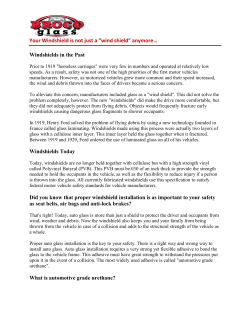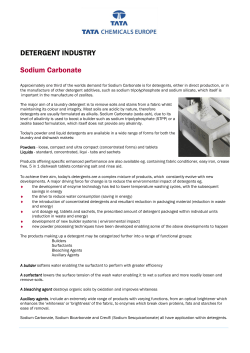
Multicyclic Carbonates as Environmentally Benign Starting Materials for Methacrylate-Urethane Monomers
Multicyclic Carbonates as Environmentally Benign Starting Materials for Methacrylate-Urethane Monomers of Low Oxygen Inhibition and Polymerization Shrinkage G. Rokicki, M. Biernat, K. Słowik and P. G. Parzuchowski, Warsaw University of Technology, Faculty of Chemistry, Noakowskiego 3, 00-664 Warsaw, Poland Email:gabro@ch.pw.edu.pl Introduction. UV-cured materials technology exhibits several advantages, such as solvent free formulations, fast curing times, low-temperature processing, and energy efficiency. However, the main disadvantage of methacrylate monomer photopolymerization is susceptibility to oxygen inhibition. The upper layer of the coatings remains uncured and tacky [1]. Recently, a new class of monomethacrylates have been developed which exhibit significant enhanced photopolymerization kinetics. These monomers contain urethane, “inverted urethane”, cyclic carbonate functionalities, sometimes in conjugation with phenyl rings [2]. An understanding of the exact causes to the enhanced reactivity of the novel methacrylates has not been established, though multiple theories have been examined. Various factors have been proposed to impact the monomer reactivity including molecular dipole interactions, hydrogen bonding, hydrogen abstraction or autoacceleration effects generated due to cross-linking. It has been proposed that the enhanced reactivity occurs due to a very efficient and rapid chain-transfer process which generates active centers more prone to propagation than termination [3,4]. In this work we present our recent results concerning synthesis and photopolymerization of multimethacrylic monomers containing urethane linkages, which were obtained via a non-isocyanate route from six- and five-membered cyclic carbonates (1, 2 and 3) using different aminoalcohols, and methacryloyl chloride as starting materials. These multimethacrylic monomers exhibit good polymerization reactivity and a low polymerization shrinkage as well as low oxygen inhibition. Experimental. Materials. 2,2’-Oxybis(methylene)bis(2-ethyl1,3-propane-1,3-diol) [di(trimetylolpropane)], 2,3-epoxypropane-1-ol (glycidol) and dimethyl carbonate were purchased from Aldrich. Diglycidyl ether of bisphenol A (DGBA) was isolated from epoxy resin Epidian 6 (Z.Ch. “Sarzyna” S.A., Poland) by distillation under reduced pressure. Other reagents (Aldrich) were used without additional purification. Syntheses of methacrylate monomers with urethane groups. Monomer 1b. To the solution of di(trimethylolpropane) (22.5 g, 0.09 mol) in 500 mL of THF cooled to below 0 °C 40,2 g (0,36 mol) of ethyl chloroformate was added dropwise maintaining reaction temperature at –3 to –10 °C. Then, triethylamine (36.4 g, 0.36 mol) was added under the same conditions. Reaction was carried out for 30 min at 0 °C and 20 min at r.t. The reaction product was recrystallized from THF leading to white crystals of six-membered biscyclic carbonate 1 (18 g, 66%). The mixture of biscyclic carbonate 1 (2.0 g, 6.6 mmol) and ethanolamine (1.43 g, 23.2 mmol) in 25 mL of THF, was stirred at room temperature for 72 h up to disappearance of the absorption band corresponding to the carbonyl group of cyclic carbonate. The liquid viscous product (tetrahydroxyurethane derivative) was reacted with methacryloyl chloride according to procedure reported in [5]. The viscous liquid (0.6 Pa⋅s was obtained (yield 60%). Monomer 2b. Tetramethacrylate diurethane monomer 2b based on 2,2-bis[4-(2,3-dihydroxypropoxy)phenyl]propane dicarbonate was prepared according to the method reported by us in [5]. Hyperbranched methacrylate 3b. Hyperbranched polymer (HBP) terminated with five-membered cyclic carbonate groups was obtained according to the method reported by us in [6]. The procedure of obtaining methacrylate-urethane derivative was analogous to the above described. Photopolymerization. The layers (ca. 30 μm) of the monomers containing 3% of camphorquinone/2-(dimethylamino)ethyl methacrylate as a photoinitiator system were irradiated using a lamp Megalux (75 W) in an air atmosphere. Results and Discussion. Multifunctional methacrylic resins containing urethane linkages were obtained from different six- and five-membered biscyclic carbonates and hyperbranched polyglycerol containing five-membered cyclic carbonate as terminal groups. Six-membered biscyclic carbonate 1 (Scheme 1) was obtained from commercially available di(trimethylolpropane) and ethyl chloroformate. Five-membered biscyclic carbonate - 2,2-bis[4-(2,3-dihydroxypropoxy)phenyl]propane dicarbonate (2), was obtained from epoxy resin based on bisphenol A and CO2. Such crystalline products can be easily purified by recrystallization. For obtaining hyperbranched polymer with cyclic carbonate groups glycidol or glycerol carbonate were used as starting materials (Scheme 3) [7]. Six-membered biscyclic carbonate 1 was first converted to a diurethane tetrol 1a by reaction with ethanoloamine. The urethane tetrol product was reacted with methacryloyl chloride to give the corresponding tetramethacrylate diurethane 1b (Scheme 1). O O OH OH OH O Et3N + 4 Cl O O OH O O O O O OH 1 2 NH2CH2CH2OH HN OH O O O O O O NH HO OH 4 O Cl O 1a Et3N HN O O O O O O O NH O O 1b O O Scheme 1. Synthesis of tetramethacrylate diurethane monomer 1b. In the tetramethacrylate diurethane (1b) based on trimethylolpropane dimer there are two types of methacrylic groups, one connected with the core via an urethane linkage and the second one via an oxygen atom. Additionally, between methacrylic groups there is longer spacer in comparison to that in multimethacrylic resin based on five-membered carbonates. The characterization of the synthesized monomers was carried out using 1H , 13C NMR and IR spectroscopies. The spectral data are in agreement with the expected structures. Figure 1. 1H NMR spectrum (400 MHz DMSO-d6) of 1b. In a similar manner five-membered biscyclic carbonate 2 was transformed into tetramethacrylate diurethane 2b (Scheme 2). In contrast to monomer 1b, in the reaction of 2 with ethanolamine three regioisomers are formed. From the comparison of the signals intensity in the 1H NMR spectrum it has been found that the isomer with primary hydroxyl group is formed with 50% higher yield than that with secondary OH group. Hyperbranched multimethacrylates were prepared by polymerization of glycidol using partially ionized trimethylolpropane as initiator (molar ratio 10:1) [8]. The selective introduction of cyclic carbonate groups was achieved by the reaction terminal vicinal OH groups with dimethyl carbonate carried out according to the method reported earlier by us (Scheme 3) [6]. In contrast to bis-GMA, the lacquer prepared from 1b and 2b after photocuring in an air atmosphere was not tacky and indicated relatively high hardness (König hardness > 0.5). CH3 O O C O O O 2 O + 2 H2N CH2CH2 OH O CH3 O HO O O HO O O N H CH3 C CH3 OH OH N H O O 0.25 3b 2a + 2 isomers O CH3 Cl C C CH2 1b 0.2 Et3N 0.15 O O N H CH3 C CH3 O O O O 4 0.1 O O O 2b p O O N H O O 0.05 O 2b + 2 isomers 0 Scheme 2. Synthesis of tetramethacrylate diurethane monomer containing bisphenol A core 2b. HO K O HO OH OH HO OH OH OH O OH THF O + H3C 95-100 O oC O O H3C OH O O HBPG HO O O K2CO3 O O O O O O O O O O O H3C O O O OH HO O O O O H3C ZnCl2 OH O O O O O + O O O OH O O O O O O O 3a O O O O O O O O O O HO HO O O O HO 1. NH2CH2CH2OH O O 2. 150 200 2b 120 O O 100 t [s] O HO HO 50 Figure 2. Conversion versus time plots for different multimethacrylate-urethanes: 1b, 2b, 3b and a typical dental resin: bis-GMA-TEGDMA (7:3) (4), cured in an air atmosphere. 3 Cl Bending strength [MPa] + 0 M10 100 1b 80 M3 M1 3b HBPG2b Bis-GMA/ TEGDMA 60 40 20 0 Figure 3. Bending strength of cured multimethacrylates: 1b, 2b, 3b and commercial dental methacrylic resins: bis-GMA and M1. O O NH O O O O NH O O O O O O O O O O O O O O H3C O O O O O O O O O O It was found that multimethacrylates with urethane linkages exhibited lower polymerization volume shrinkage than that obtained for bis-GMA - TEGDMA compositions. Table 1. Volume polymerization shrinkages of multifunctional methacrylate-urethane monomers. O O 3b Monomer O Scheme 3. Synthesis of hyperbranched multimethacrylate 3b. To reduce hydrophilic properties of HBPG the remaining hydroxyl groups in the inner sphere were blocked in the reaction with acetic anhydride. The viscosity of this branched product (2.5 Pa⋅s, 25 °C) was much lower than that of bis-GMA (500 Pa⋅s, 25 °C) Photopolymerization of the multimethacrylate monomers and theirs compositions with typical dental components (bis-GMA-TEGDMA) was investigated with respect to oxygen inhibition. Kinetic investigations of photopolymerization were carried out by measuring of double bonds conversion using FTIR spectroscopy as well as confocal Raman microscopy. It was found that the conversion of multifunctional monomers containing urethane linkages is greater than that of composition with bis-GMA for the same irradiation time (Fig. 2). The presence of four methacrylic groups in a monomer molecule leads to fast increase in viscosity which decrease the oxygen solubility and suppresses inhibition in an upper layer of the resin. Additionally, formation of hydrogen bonds between urethane groups leads to faster crosslinking of the resin. Fig. 2 shows the effect of monomer structure on the conversion. The highest conversion was observed for hyperbranched methacrylate 3b, followed in order by tetramethacrylate based on di(trimethylolpropane) 1b and bisphenol A 2b. Despite of lower conversion of double bonds the cured 2b exhibited the highest bending strength, 100 MPa (Fig.3) and volumetric polymerization shrinkage (Table 1). 2b 3b Bis-GMA - TEGDMA Volumetric shrinkage, (%) 3.9 ± 0.2 5.0 ± 0.2 10.4 ± 0.4 Developed method of synthesis of multimethacrylates containing urethane linkages via cyclic carbonates is safer and more environmentally friendly than those involving isocyanates and phosgene. Such monomers after UV curing in air are characterized by higher conversions and reaction rates, lower volume shrinkage and good mechanical properties. Acknowledgements. This paper is based upon work supported by the Polish Ministry of Science and Higher Education (3 T09B 072 29; 2005-2008). References: [1] Andrzejewska, E. Prog. Polym. Sci. 2001, 26, 605. [2] Jansen, J. F. G.; Dias, A.A.; Dorschu, M.; Coussens, B. Macromolecules 2003, 36, 3861., [3] Podszun, W.; Schäpers, K.; Finger, W.; Heiliger, L.; Cesser, C. US Pat. 5 621 119, 1997. [4] Jansen, J. F. G. A.; Dias, A. A., Dorschu, M.; Coussens, B. Macromolecules 2002, 35, 7529. [5] Biernat, M.; Rokicki, G. e-Polymers 2005, P32. [6] Parzuchowski, P. G.; Kiźlińska, M.; Rokicki, G.; Polymer 2007, 48, 1857. [7] Rokicki, G.; Rakoczy, P.; Parzuchowski, P. G.; Sobiecki, M. Green Chem. 2005, 7, 529. [8] Sunder, A.; Hanselmann, R. Frey, H. Mülhaupt, R. Macromolecules, 1999, 32, 4240. [9] Ge, M.; Trujillo, J.; Stansbury, J. Dental Materials 2005, 21, 1163.
© Copyright 2025

















